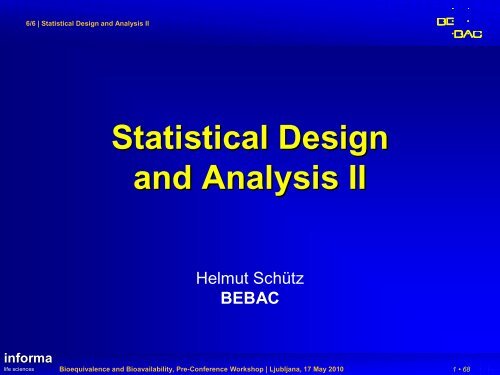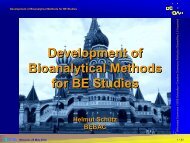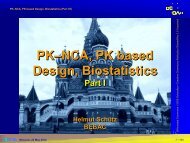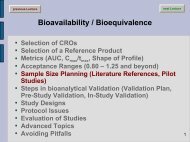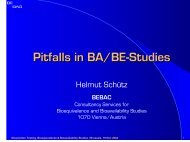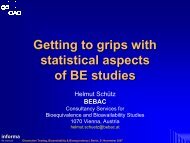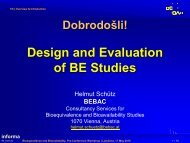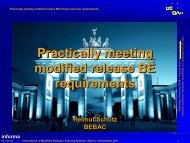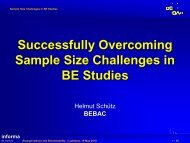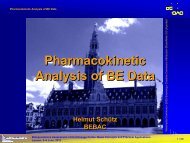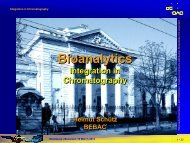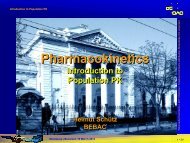Part II - BEBAC ⢠Consultancy Services for Bioequivalence
Part II - BEBAC ⢠Consultancy Services for Bioequivalence
Part II - BEBAC ⢠Consultancy Services for Bioequivalence
You also want an ePaper? Increase the reach of your titles
YUMPU automatically turns print PDFs into web optimized ePapers that Google loves.
6/6 | Statistical Design and Analysis <strong>II</strong>IMaximum Sample SizeNew Zealand ‘If the calculated number of subjects appears to be higher thanis ethically justifiable, it may be necessary to accept astatistical power which is less than desirable. Normally it is notpractical to use more than about 40 subjects in abioavailability study.’All others Not specified in Guidelines (judged by IEC/IRB or localAuthorities); ICH E9, Section 3.5 applies: ‘The number ofsubjects in a clinical trial should always be large enough toprovide a reliable answer to the questions addressed.’in<strong>for</strong>malife sciences<strong>Bioequivalence</strong> and Bioavailability, Pre-Conference Workshop | Ljubljana, 17 May 20103 • 68
6/6 | Statistical Design and Analysis <strong>II</strong>IEUNfG on the Investigation of BA/BE (2001)The number of subjects required is determined by the error variance associated with the primarycharacteristic to be studied as estimated from a pilot experiment, previous studies, or published data, the significance level desired, the expected deviation (∆) from the reference productcompatible with BE and, the required power.in<strong>for</strong>malife sciences<strong>Bioequivalence</strong> and Bioavailability, Pre-Conference Workshop | Ljubljana, 17 May 20104 • 68
6/6 | Statistical Design and Analysis <strong>II</strong>IEUNfG on the Investigation of BA/BE (2001)Problems/solutions… the error variance associated with theprimary characteristic to be studied … Since BE must be shown both <strong>for</strong> AUC and C max , and, if you plan your sample size only <strong>for</strong> the ‘primary characteristic’(e.g., AUC), in many cases you will fail <strong>for</strong> thesecondary parameter (e.g., C max ), which most likely showshigher variability – your study will be ‘underpowered’. Based on the assumption, that CV is identical <strong>for</strong> test andreference (what if only the reference <strong>for</strong>mulation has highvariability, e.g., some <strong>for</strong>mulations of PPIs?).in<strong>for</strong>malife sciences<strong>Bioequivalence</strong> and Bioavailability, Pre-Conference Workshop | Ljubljana, 17 May 20105 • 68
6/6 | Statistical Design and Analysis <strong>II</strong>IEUNfG on the Investigation of BA/BE (2001)Problems/solutions … as estimated from a pilot experiment, previous studies, or published data, The correct order should read:1. previous studies → 2. pilot study → 3. published data Only in the first case you ‘know’ all constraints resultingin variability Pilot studies are often too small to get reliable estimatesof variability Advisable only if you have data from a couple of studiesin<strong>for</strong>malife sciences<strong>Bioequivalence</strong> and Bioavailability, Pre-Conference Workshop | Ljubljana, 17 May 20106 • 68
6/6 | Statistical Design and Analysis <strong>II</strong>IEUNfG on the Investigation of BA/BE (2001)Problems/solutions … the significance level desired … Throughout the NfG the significance level(α, error type I: patient’s risk to be treated with abioinequivalent drug) is fixed to 5% (correspondingto a 90% confidence interval) You may desire a higher significance level, but sucha procedure is not considered acceptable In special cases (e.g., dose proportionality testing),a correction <strong>for</strong> multiplicity may be necessary In some legislations (e.g., Brazil’s ANVISA), α must betightened to 2.5% <strong>for</strong> NTIDs (95% confidence interval)in<strong>for</strong>malife sciences<strong>Bioequivalence</strong> and Bioavailability, Pre-Conference Workshop | Ljubljana, 17 May 20107 • 68
6/6 | Statistical Design and Analysis <strong>II</strong>IEUEMA BE Guideline (2010)The number of subjects to be included in the studyshould be based on anappropriateCookbook?sample size calculation.in<strong>for</strong>malife sciences<strong>Bioequivalence</strong> and Bioavailability, Pre-Conference Workshop | Ljubljana, 17 May 201010 • 68
6/6 | Statistical Design and Analysis <strong>II</strong>IHintsLiterature search <strong>for</strong> CV%Preferably other BE studies (the bigger, the better!)PK interaction studies (Cave: mainly in steadystate! Generally lower CV than after SD)Food studies (CV higher/lower than fasted!)If CV intra is not given (quite often), a little algebrahelps. All you need is the 90% geometricconfidence interval and the sample size. Point estimate (PE) from the CIPE = CL ⋅CLlohiin<strong>for</strong>malife sciences<strong>Bioequivalence</strong> and Bioavailability, Pre-Conference Workshop | Ljubljana, 17 May 201011 • 68
6/6 | Statistical Design and Analysis <strong>II</strong>IAlgebra…Calculation of CV intra from CI Estimate the number of subjects / sequence (example2×2 cross-over) If total sample size (N) is an even number, assume (!)n 1 = n 2 = ½N If N is an odd number, assume (!)n 1 = ½N + ½, n 2 = ½N – ½ (not n 1 = n 2 = ½N!) Difference between one CL and the PE in log-scale; usethe CL which is given with more significant digits∆ = ln PE − ln CL or ∆ = ln CL − ln PECL lo CL hiin<strong>for</strong>malife sciences<strong>Bioequivalence</strong> and Bioavailability, Pre-Conference Workshop | Ljubljana, 17 May 201012 • 68
6/6 | Statistical Design and Analysis <strong>II</strong>IAlgebra…Calculation of CV intra from CI Calculate the Mean Square Error (MSE)MSE⎛⎞⎜⎟⎜ ∆CL⎟= 2 ⎜ ⎟⎜ ⎛ 1 1 ⎞+ ⋅t⎟1−2 ⋅ α , n1 + n2−2⎜ ⎜n1 n⎟ ⎟⎝ ⎝ 2 ⎠ ⎠ CV intra from MSE as usual% 100 MSECV1intra= ⋅ e −2in<strong>for</strong>malife sciences<strong>Bioequivalence</strong> and Bioavailability, Pre-Conference Workshop | Ljubljana, 17 May 201013 • 68
6/6 | Statistical Design and Analysis <strong>II</strong>IAlgebra…Calculation of CV intra from CI Example: 90% CI [0.91 – 1.15], N 21 (n 1 = 11, n 2 = 10)PE = 0.91⋅ 1.15 = 1.023∆ = ln1.15 − ln1.023 = 0.11702CLMSECV⎛⎞⎜⎟0.11702= 2⎜⎟ = 0.04798⎜ ⎛ 1 1 ⎞ ⎟⎜ ⎜ + ⎟ × 1.729 ⎟⎝ ⎝11 10 ⎠ ⎠0.04798intra% = 100 × e − 1 = 22.2%2in<strong>for</strong>malife sciences<strong>Bioequivalence</strong> and Bioavailability, Pre-Conference Workshop | Ljubljana, 17 May 201014 • 68
6/6 | Statistical Design and Analysis <strong>II</strong>IAlgebra…Proof: CI from calculated values Example: 90% CI [0.91 – 1.15], N 21 (n 1 = 11, n 2 = 10)ln PE = ln CL ⋅ CL = ln 0.91× 1.15 = 0.02274SE∆lohi2 ⋅ MSE 2 × 0.04798= = = 0.067598N 21CI = e ∆ = eCICIln PE± t⋅ SE 0.02274± 1.729×0.0675980.02274− 1.729×0.067598lo= e= 0.910.02274+ 1.729×0.067598hi= e= 1.15in<strong>for</strong>malife sciences<strong>Bioequivalence</strong> and Bioavailability, Pre-Conference Workshop | Ljubljana, 17 May 201015 • 68
6/6 | Statistical Design and Analysis <strong>II</strong>ISensitivity to ImbalanceIf the study was more imbalanced that youassumed, the estimated CV is conservative Example: 90% CI [0.89 – 1.15], N 24 (n 1 = 16, n 2 = 8, butnot reported as such); CV 24.74% in the studyn 11213141516n 212111098CV%26.2926.2025.9125.4324.74in<strong>for</strong>malife sciences<strong>Bioequivalence</strong> and Bioavailability, Pre-Conference Workshop | Ljubljana, 17 May 201016 • 68
6/6 | Statistical Design and Analysis <strong>II</strong>ILiterature data12108frequency642total0101 520C V s253 02 00 m g100 m gstudiesin<strong>for</strong>malife sciencesDoxicycline (37 studies from Blume/Mutschler, Bioäquivalenz: Qualitätsbewertung wirkstoffgleicherFertigarzneimittel, GOVI-Verlag, Frankfurt am Main/Eschborn, 1989-1996)<strong>Bioequivalence</strong> and Bioavailability, Pre-Conference Workshop | Ljubljana, 17 May 201017 • 68
6/6 | Statistical Design and Analysis <strong>II</strong>IPooling of CV%Intra-subject CV from different studies can bepooledDo not use the arithmetic mean (or the geometricmean either) of CVsIn the parametric model of log-trans<strong>for</strong>med data,additivity of variances (not of CVs!) applyBe<strong>for</strong>e pooling variances must be weightedacccording to the sample sizeCalculate the variance from CVσ = ln( CV + 1)2 2Wintrain<strong>for</strong>malife sciences<strong>Bioequivalence</strong> and Bioavailability, Pre-Conference Workshop | Ljubljana, 17 May 201018 • 68
6/6 | Statistical Design and Analysis <strong>II</strong>IPooling of CV%Intra-subject CV from different studiesCalculate the total variance weighted by degreesof freedom∑σ 2df WCalculate the pooled CV from total variance2CV e σ Wdf df=∑ ∑−1Optionally calculate an upper (1-α) % confidencelimit on the pooled CV (recommended α=0.20)CLCV∑ σ χ − ∑2 2Wdf1 α , df1= e −in<strong>for</strong>malife sciences<strong>Bioequivalence</strong> and Bioavailability, Pre-Conference Workshop | Ljubljana, 17 May 201019 • 68
6/6 | Statistical Design and Analysis <strong>II</strong>IPooling of CV%Example 1: n 1 =n 2 ;CV Study1 < CV Study2studies N df (total) α 1-α total CV pooled CV mean2 24 20 0.2 0.8 1.2540 0.254 0.245χ² (1-α,df) 14.578 0.300 +17.8%CV intra n seq. df (mj) σ W σ² W σ² W × dfCV intra /pooled>CL upper0.200 12 2 10 0.198 0.0392 0.3922 78.6% no0.300 12 2 10 0.294 0.0862 0.8618 117.9% yesin<strong>for</strong>malife sciences<strong>Bioequivalence</strong> and Bioavailability, Pre-Conference Workshop | Ljubljana, 17 May 201020 • 68
6/6 | Statistical Design and Analysis <strong>II</strong>IPooling of CV%Example 2: n 1 CL upper0.200 12 2 10 0.198 0.0392 0.3922 73.5% no0.300 24 2 22 0.294 0.0862 1.8959 110.2% noin<strong>for</strong>malife sciences<strong>Bioequivalence</strong> and Bioavailability, Pre-Conference Workshop | Ljubljana, 17 May 201021 • 68
6/6 | Statistical Design and Analysis <strong>II</strong>IPooling of CV%Example 3: n 1 >n 2 ;CV Study1 < CV Study2studies N df (total) α 1-α total CV pooled CV mean2 36 32 0.2 0.8 1.7246 0.235 0.245χ² (1-α,df) 25.148 0.266 +13.2%CV intra n seq. df (mj) σ W σ² W σ² W × dfCV intra /pooled>CL upper0.200 24 2 22 0.198 0.0392 0.8629 85.0% no0.300 12 2 10 0.294 0.0862 0.8618 127.5% yesin<strong>for</strong>malife sciences<strong>Bioequivalence</strong> and Bioavailability, Pre-Conference Workshop | Ljubljana, 17 May 201022 • 68
6/6 | Statistical Design and Analysis <strong>II</strong>Iα- vs. β-Errorin<strong>for</strong>malife sciencesα-Error (aka error type I): patient’s risk to betreated with a bioinequivalent <strong>for</strong>mulationReminder: BA in a particular patient can be eitherbelow 80% or above 125%.If we keep the risk of particular patients at 0.05 (5%),the risk of entire the population of patients (125%) is 2×α (10%)That’s where the 90% confidence intervalcomes from (CI = 1 – 2×α = 0.90)Although α is generally set to 0.05, sometimes
6/6 | Statistical Design and Analysis <strong>II</strong>Iα- vs. β-Errorin<strong>for</strong>malife sciencesβ-Error (aka error type <strong>II</strong>): producer’s risk to getno approval <strong>for</strong> a bioequivalent <strong>for</strong>mulationGenerally set in study planning to ≤0.2, wherepower = 1 - β = ≥80%No guidelines about power (‘appropriate’), but70% only in exceptional cases>90% may raise questions from the Ethics Committee(suspection of ‘<strong>for</strong>ced bioequivalence’)There is no a posteriori (aka post hoc) power!Either a study has shown BE or not.Phoenix’/WinNonlin’s output is statistical nonsense!<strong>Bioequivalence</strong> and Bioavailability, Pre-Conference Workshop | Ljubljana, 17 May 201024 • 68
6/6 | Statistical Design and Analysis <strong>II</strong>IPower vs. Sample Sizein<strong>for</strong>malife sciencesIt is not possible to directly calculate theneeded sample size.Power is calculated instead, and the lowestsample size which fulfills the minimum targetpower is used.Example: α 0.05, target power 80%(β=0.2), T/R 0.95, CV intra 20% →minimum sample size 19 (power 81%),rounded up to the next even number ina 2×2 study (power 83%).<strong>Bioequivalence</strong> and Bioavailability, Pre-Conference Workshop | Ljubljana, 17 May 2010n power16 73.54%17 76.51%18 79.12%19 81.43%20 83.47%25 • 68
6/6 | Statistical Design and Analysis <strong>II</strong>IToolsSpecialized Software (nQuery Advisor, PASS,FARTSSIE, StudySize, …)General purpose (SAS, R, S+, StaTable, …)Sample Size Tables (Phillips, Diletti, Hauschke,Chow, Julious, …)Approximations (Diletti, Chow, Julious, …)in<strong>for</strong>malife sciences<strong>Bioequivalence</strong> and Bioavailability, Pre-Conference Workshop | Ljubljana, 17 May 201026 • 68
6/6 | Statistical Design and Analysis <strong>II</strong>IBackgroundReminder: Sample Size is not directlyobtained; only powerSolution given by DB Owen (1965) as adifference of two bivariate noncentral t-distributionsDefinite integrals cannot be solved in closed <strong>for</strong>m‘Exact’ methods rely on numerical methods (currentlythe most advanced is AS 243 of RV Lenth;implemented in R, FARTSSIE, EFG). nQuery uses anearlier version (AS 184).in<strong>for</strong>malife sciences<strong>Bioequivalence</strong> and Bioavailability, Pre-Conference Workshop | Ljubljana, 17 May 201027 • 68
6/6 | Statistical Design and Analysis <strong>II</strong>IBackgroundPower calculations…‘Brute <strong>for</strong>ce’ methods (also called ‘resampling’ or‘Monte Carlo’) converge asymptotically to the truepower; need a good random number generator (e.g.,Mersenne Twister) and may be time-consuming‘Asymptotic’ methods use large sampleapproximationsApproximations provide algorithms which shouldconverge to the desired power based on thet-distributionin<strong>for</strong>malife sciences<strong>Bioequivalence</strong> and Bioavailability, Pre-Conference Workshop | Ljubljana, 17 May 201028 • 68
6/6 | Statistical Design and Analysis <strong>II</strong>IComparisonin<strong>for</strong>malife sciencesCV%original values Method Algorithm 5. 7.5 10. 12. 12.5 14. 15. 16. 17.5 18. 20. 22.Patterson & Jones (2006) exact AS 243 4 5 7 8 9 11 12 13 15 16 19 22Diletti et al. (1991) exact ? 4 5 7 9 12 15 19nQuery Advisor 7 (2007) exact AS 184 4 6 8 8 10 12 12 14 16 16 20 22FARTSSIE 1.6 (2008) exact AS 243 4 5 7 8 9 11 12 13 15 16 19 22EFG 1.01 (2009)exact AS 243 4 5 7 8 9 11 12 13 15 16 19 22brute <strong>for</strong>ce ElMaestro 4 5 7 8 9 11 12 13 15 16 19 22StudySize 2.0.1 (2006) asympt. ? 5 7 8 9 11 12 13 15 16 19 22Hauschke et al. (1992) approx. 8 8 10 12 12 14 16 16 20 22Chow & Wang (2001) approx. 6 6 8 8 10 12 12 14 16 18 22Kieser & Hauschke (1999) approx. 2 6 8 10 12 14 16 20 24CV%original values Method Algorithm 22.5 24. 25. 26. 27.5 28. 30. 32. 34. 36. 38. 40.Patterson & Jones (2006) exact AS 243 23 26 28 30 33 34 39 44 49 54 60 66Diletti et al. (1991) exact ? 23 28 33 39nQuery Advisor 7 (2007) exact AS 184 24 26 28 30 34 34 40 44 50 54 60 66FARTSSIE 1.6 (2008) exact AS 243 23 26 28 30 33 34 39 44 49 54 60 66EFG 1.01 (2009)exact AS 243 23 26 28 30 33 34 39 44 49 54 60 66brute <strong>for</strong>ce ElMaestro 23 26 28 30 33 34 39 44 49 54 60 66StudySize 2.0.1 (2006) asympt. ? 23 26 28 30 33 34 39 44 49 54 60 66Hauschke et al. (1992) approx. 24 26 28 30 34 36 40 46 50 56 64 70Chow & Wang (2001) approx. 24 26 28 30 34 34 38 44 50 56 62 68Kieser & Hauschke (1999) approx. 28 30 32 38 42 48 54 60 66 74<strong>Bioequivalence</strong> and Bioavailability, Pre-Conference Workshop | Ljubljana, 17 May 201029 • 68
6/6 | Statistical Design and Analysis <strong>II</strong>IApproximationsin<strong>for</strong>malife sciencesHauschke D, Steinijans VW, Diletti E, and M BurkeSample Size Determination <strong>for</strong> <strong>Bioequivalence</strong>Assessment Using a Multiplicative ModelJ Pharmacokin Biopharm 20/5, 557-561 561 (1992)Patient’s risk α 0.05, Power 80% (Producer’s risk β0.2), AR [0.80 – 1.25], CV 0.2 (20%), T/R 0.951. ∆ = ln(0.8)-ln(T/R) ln(T/R) = -0.17192. Start with e.g. n=8/sequence1. df = n 2 – 1 = 8 × 2 - 1 = 142. t α,df= 1.76133. t β,df= 0.86814. new n = [(t α,df+ t β,df)²(CV/∆)])]² =(1.7613+0.8681)² × (-0.2/(0.2/0.1719)0.1719)² = 9.35803. Continue with n=9.3580/sequence (N=18.716 → 19)1. df = 16.716; roundup to the next integer 172. t α,df= 1.73963. t β,df= 0.86334. new n = [(t α,df+ t β,df)²(CV/∆)])]² =(1.7396+0.8633)² × (-0.2/(0.2/0.1719)0.1719)² = 9.17114. Continue with n=9.1711/sequence (N=18.3422 → 19)1. df = 17.342; roundup to the next integer 182. t α,df= 1.73413. t β,df= 0.86204. new n = [(t α,df+ t β,df)²(CV/∆)])]² =(1.7341+0.8620)² × (-0.2/(0.2/0.1719)0.1719)² = 9.12335. Convergence reached (N=18.2466 → 19):Use 10 subjects/sequence (20(total)<strong>Bioequivalence</strong> and Bioavailability, Pre-Conference Workshop | Ljubljana, 17 May 2010S-C C Chow and H WangOn Sample Size Calculation in <strong>Bioequivalence</strong> TrialsJ Pharmacokin Pharmacodyn 28/2, 155-169 169 (2001)Patient’s risk α 0.05, Power 80% (Producer’s risk β0.2), AR [0.80 – 1.25], CV 0.2 (20%), T/R 0.951. ∆ = ln(T/R) – ln(1.25) = 0.17192. Start with e.g. n=8/sequence1. df = roundup(2n-2)2α2)2-2 2 = (2×8-2)×22)×2-2 2 = 262. df β= roundup(4n-2) = 4×8-2 = 303. t α,df= 1.70564. t β/2/2,df= 0.85385. new n = β²²[(tα,df+ t β/2/2,df)²/∆² =0.2² × (1.7056+0.8538)² / 0.1719² = 8.87233. Continue with n=8.8723/sequence (N=17.7446 → 18)1. df = roundup(2n-2)2α2)2-2=(2×8.87232=(2×8.8723-2)×22)×2-2 2 = 302. df β= roundup(4n-2) = 4×8.8723-2 2 = 343. t α,df= 1.69734. t β/2/2,df= 0.85235. new n = β²²[(tα,df+ t β/2/2,df)²/∆² =0.2² × (1.6973+0.8538)² / 0.1719² = 8.80454. Convergence reached (N=17.6090 → 18):Use 9 subjects/sequence (18(total)sample size 18 19 20power % 79.124 81.428 83.46830 • 68
6/6 | Statistical Design and Analysis <strong>II</strong>IApproximations obsoletein<strong>for</strong>malife sciencesExact sample size tables still useful inchecking the plausibility of software’s resultsApproximations obsolete,since exact methodavailable (FARTSSIE17)or …http://individual.utoronto.ca/ddubins/FARTSSIE17.xls<strong>Bioequivalence</strong> and Bioavailability, Pre-Conference Workshop | Ljubljana, 17 May 2010alpha
6/6 | Statistical Design and Analysis <strong>II</strong>IPower CurvesPower to show2×2 Cross-overBE with 12 – 36subjects <strong>for</strong>CV intra = 20%n 24 → 16:power 0.896→ 0.735Power10.90.80.70.60.50.40.30.23624161220% CVin<strong>for</strong>malife sciencesµ T /µ R 1.05 → 1.10:power 0.903→ 0.700<strong>Bioequivalence</strong> and Bioavailability, Pre-Conference Workshop | Ljubljana, 17 May 20100.100.8 0.85 0.9 0.95 1 1.05 1.1 1.15 1.2 1.25µT/µR32 • 68
6/6 | Statistical Design and Analysis <strong>II</strong>IEU GL on BE (2010)HVDs/HVDPsThe regulatory switching condition θ s is derivedfrom the regulatory standardized variation σ 0 .For CV WR = 30% we get2σ0= ln(0.3 + 1) = 0.2936andθ sln(1.25)= = 0.7601σ0in<strong>for</strong>malife sciencesTothfalusi L, Endrenyi L and A Garcia ArietaEvaluation of <strong>Bioequivalence</strong> <strong>for</strong> Highly Variable Drugs with Scaled Average <strong>Bioequivalence</strong>Clin Pharmacokinet 48/11, 725-743 (2009)<strong>Bioequivalence</strong> and Bioavailability, Pre-Conference Workshop | Ljubljana, 17 May 201033 • 68
6/6 | Statistical Design and Analysis <strong>II</strong>IEU GL on BE (2010)HVDs/HVDPsAverage <strong>Bioequivalence</strong> (ABE) with ExpandingLimits (ABEL) If you have σ WR(the intra-subject standard deviationof the reference <strong>for</strong>mulation) go to the next step;if not, calculate it from CV WR: Calculate the scaled acceptance range based on theregulatory constant k (0.7601):[ ]U L e σ2ln( CVWR1)σ = +WRk WR, =± ⋅in<strong>for</strong>malife sciences<strong>Bioequivalence</strong> and Bioavailability, Pre-Conference Workshop | Ljubljana, 17 May 201034 • 68
6/6 | Statistical Design and Analysis <strong>II</strong>IEU GL on BE (2010)HVDs/HVDPsScaling allowed <strong>for</strong> C max only (not AUC!)based on CV WR >30% in the study.Limited to a maximum of CV WR 50% (i.e., higherCVs are treated as if CV = 50%).PE restricted with 80% – 125% in any case.No commercial software <strong>for</strong> sample size estimationcan handle the PE restriction.Expect a solution from thecommunity soon…in<strong>for</strong>malife sciences<strong>Bioequivalence</strong> and Bioavailability, Pre-Conference Workshop | Ljubljana, 17 May 201035 • 68
6/6 | Statistical Design and Analysis <strong>II</strong>IHVDs/HVDPsEU GL on BE (2010)CV% L% U%30 80.00 125.0032 78.87 126.7934 77.77 128.5836 76.69 130.3938 75.64 132.2040 74.61 134.0242 73.61 135.8544 72.63 137.6846 71.68 139.5248 70.74 141.3650 69.83 143.20Acceptance limits [% Ref.]15014013012011010090807060EU SABE20 30 40 50 60in<strong>for</strong>malife sciences<strong>Bioequivalence</strong> and Bioavailability, Pre-Conference Workshop | Ljubljana, 17 May 2010µT/µR36 • 68
6/6 | Statistical Design and Analysis <strong>II</strong>IHVDs/HVDPsin<strong>for</strong>malife sciencesTotfalushi et al. (2009), Fig. 3Simulated (n=10000) three-period replicate design studies (TRT-RTR) in 36 subjects;GMR restriction 0.80–1.25. (a) CV=35%, (b) CV=45%, (c) CV=55%.ABE: Conventional Average <strong>Bioequivalence</strong>, SABE: Scaled Average <strong>Bioequivalence</strong>,0.76: EU criterion, 0.89: FDA criterion.<strong>Bioequivalence</strong> and Bioavailability, Pre-Conference Workshop | Ljubljana, 17 May 201037 • 68
6/6 | Statistical Design and Analysis <strong>II</strong>IHVDs/HVDPsin<strong>for</strong>malife sciencesReplicate designs4-period replicate designs:sample size = ½ of 2×2 study’s sample size3-period replicate designs:sample size = ¾ of 2×2 study’s sample sizeReminder: number of treatments (and biosamples)is identical to the concentional 2×2 cross-over.Allow <strong>for</strong> a safety margin – expect a higher numberof drop-outs due to the additional period(s).Consider increased blood loss (ethics!)Eventually bioanalytics has to be improved.<strong>Bioequivalence</strong> and Bioavailability, Pre-Conference Workshop | Ljubljana, 17 May 201038 • 68
6/6 | Statistical Design and Analysis <strong>II</strong>IExample ABELin<strong>for</strong>malife sciencesRTR–TRT Replicate Design, n=18Subj Seq Per Trt Cmax Subj Seq Per Trt Cmax Subj Seq Per Trt Cmax1 1 1 R 209.91 7 1 1 R 58.49 13 2 1 T 92.761 1 2 T 111.05 7 1 2 T 62.80 13 2 2 R 59.541 1 3 R 116.36 7 1 3 R 123.23 13 2 3 T 56.842 1 1 R 101.16 8 1 1 R 105.34 14 2 1 T 159.202 1 2 T 100.31 8 1 2 T 103.32 14 2 2 R 155.502 1 3 R 31.71 8 1 3 R 43.67 14 2 3 T 165.313 1 1 R 14.83 9 1 1 R 59.73 15 2 1 T 162.413 1 2 T 57.10 9 1 2 T 169.03 15 2 2 R 47.313 1 3 R 21.47 9 1 3 R 48.26 15 2 3 T 88.234 1 1 R 118.71 10 1 1 R 38.34 16 2 1 T 19.444 1 2 T 37.34 10 1 2 T 31.19 16 2 2 R 42.804 1 3 R 52.29 10 1 3 R 19.43 16 2 3 T 18.935 1 1 R 36.11 11 2 1 T 51.95 17 2 1 T 90.585 1 2 T 83.95 11 2 2 R 195.71 17 2 2 R 42.395 1 3 R 17.76 11 2 3 T 65.87 17 2 3 T 54.576 1 1 R 146.44 12 2 1 T 18.72 18 2 1 T 42.966 1 2 T 40.45 12 2 2 R 20.63 18 2 2 R 171.866 1 3 R 38.34 12 2 3 T 7.45 18 2 3 T 59.15<strong>Bioequivalence</strong> and Bioavailability, Pre-Conference Workshop | Ljubljana, 17 May 201039 • 68
6/6 | Statistical Design and Analysis <strong>II</strong>IExample ABEL σ WR(WinNonlin)in<strong>for</strong>malife sciencesCalculate the scaled acceptance range based on theregulatory constant k (0.7601) and the limiting CV:[ ]U L e σk WR, =± ⋅σ WR 0.4628CV WR 0.4887L 0.7154U 1.3977CV2exp(WR1)<strong>Bioequivalence</strong> and Bioavailability, Pre-Conference Workshop | Ljubljana, 17 May 2010WR= σ −30%
6/6 | Statistical Design and Analysis <strong>II</strong>IExample ABELin<strong>for</strong>malife sciencesABEPE: 99.8990% CI:72.04, 138.52failed ABEfailed 75 – 13330
6/6 | Statistical Design and Analysis <strong>II</strong>ISensitivity AnalysisICH E9Section 3.5 Sample Size, paragraph 3 The method by which the sample size is calculatedshould be given in the protocol […]. The basis ofthese estimates should also be given. It is important to investigate the sensitivity of thesample size estimate to a variety of deviations fromthese assumptions and this may be facilitated byproviding a range of sample sizes appropriate <strong>for</strong> areasonable range of deviations from assumptions. In confirmatory trials, assumptions should normallybe based on published data or on the results ofearlier trials.in<strong>for</strong>malife sciences<strong>Bioequivalence</strong> and Bioavailability, Pre-Conference Workshop | Ljubljana, 17 May 201042 • 68
6/6 | Statistical Design and Analysis <strong>II</strong>ISensitivity AnalysisExamplenQuery Advisor:σ = ln( CV + 1); ln(0.2 + 1) = 0.198042w2 2intrain<strong>for</strong>malife sciences20% CV:n=2625% CV:power 90% → 78%20% CV, 4 drop outs:power 90% → 87%25% CV, 4 drop outs:power 90% → 69%<strong>Bioequivalence</strong> and Bioavailability, Pre-Conference Workshop | Ljubljana, 17 May 201020% CV, PE 90%:power 90% → 69%43 • 68
6/6 | Statistical Design and Analysis <strong>II</strong>ISensitivity Analysisin<strong>for</strong>malife sciencesMust be done be<strong>for</strong>e the study (a priori)A posteriori power:High values do not support the claim of alreadydemonstrated bioequivalenceLow values do not invalidate a bioequivalent<strong>for</strong>mulationFurther reader:JM Hoenig and DM HeiseyThe Abuse of Power: The Pervasive Fallacy of Power Calculations <strong>for</strong> Data AnalysisThe American Statistician 55/1, 19–24 (2001)http://www.math.uiowa.edu/~rlenth/Power/2badHabits.pdfRV LenthTwo Sample-Size Practices that I don’t recommendJoint Statistical Meetings, Indianapolis (2000)http://www.math.uiowa.edu/~rlenth/Power/2badHabits.pdf<strong>Bioequivalence</strong> and Bioavailability, Pre-Conference Workshop | Ljubljana, 17 May 201044 • 68
6/6 | Statistical Design and Analysis <strong>II</strong>ISample Size: Pilot StudiesPilot StudiesSmall pilot studies (sample size
6/6 | Statistical Design and Analysis <strong>II</strong>IJustificationGood Scientific Practice!Every influental factor can be tested in a pilot study.Sampling schedule: matching C max, lag-time (firstpoint C maxproblem), reliable estimate of λ zBioanalytical method: LLOQ, ULOQ, linear range,metabolite interferences, ICSRFood, posture,…Variabilty of PK metricsLocation of PEin<strong>for</strong>malife sciences<strong>Bioequivalence</strong> and Bioavailability, Pre-Conference Workshop | Ljubljana, 17 May 201046 • 68
6/6 | Statistical Design and Analysis <strong>II</strong>IJustificationBest description by FDA (2003)The study can be used to validate analytical methodology,assess variability, optimize sample collectiontime intervals, and provide other in<strong>for</strong>mation.For example, <strong>for</strong> conventional immediate-releaseproducts, careful timing of initial samples may avoida subsequent finding in a full-scale study that thefirst sample collection occurs after the plasma concentrationpeak. For modified-release products, apilot study can help determine the samplingschedule to assess lag time and dose dumping.in<strong>for</strong>malife sciences<strong>Bioequivalence</strong> and Bioavailability, Pre-Conference Workshop | Ljubljana, 17 May 201047 • 68
6/6 | Statistical Design and Analysis <strong>II</strong>IApplicationMost common to assess CV and PE needed insample size estimation <strong>for</strong> a pivotal BE studyTo select between candidate test <strong>for</strong>mulationscompared to one referenceTo find a suitable referenceIf design issues (clinical per<strong>for</strong>mance, bioanalytics)are already known, a two-stage sequential designwould be a better alternative!in<strong>for</strong>malife sciences<strong>Bioequivalence</strong> and Bioavailability, Pre-Conference Workshop | Ljubljana, 17 May 201048 • 68
6/6 | Statistical Design and Analysis <strong>II</strong>IDrawbacksCV-estimates have a high degree ofuncertainty (in the pivotal study it is more likelythat you will be able to reproduce the PE, thanthe CV)The smaller the size of the pilot, the more uncertainthe outcome.The more <strong>for</strong>mulations you have tested, lesserdegrees of freedom will result in worse estimates.in<strong>for</strong>malife sciences<strong>Bioequivalence</strong> and Bioavailability, Pre-Conference Workshop | Ljubljana, 17 May 201049 • 68
6/6 | Statistical Design and Analysis <strong>II</strong>ISolutionsDo not use the pilot study’s CV, but calculatean upper confidence interval!Gould recommends a 75% CI (i.e., a producer’s riskof 25%).Unless you are under time pressure, a two-stagedesign will help in dealing with the uncertainestimate from the pilot.in<strong>for</strong>malife sciencesLA GouldGroup Sequential Extension of a Standard <strong>Bioequivalence</strong> Testing ProcedureJ Pharmacokin Biopharm 23/1, 57-86 (1995)<strong>Bioequivalence</strong> and Bioavailability, Pre-Conference Workshop | Ljubljana, 17 May 201050 • 68
6/6 | Statistical Design and Analysis <strong>II</strong>ISample Size: Pilot StudiesPilot Studies (cont’d)Moderate sized pilot studies (sample size ~12–24)lead to more consistent results(both CV intra and PE). If you stated a procedure in your protocol, even BE may beclaimed in the pilot study, and no further study will benecessary. If you have some previous hints of high intra-subjectvariability (>30%), a pilot study size of at least 24 subjectsis reasonable.A Sequential Design may also avoid an unnecessary largepivotal study.in<strong>for</strong>malife sciences<strong>Bioequivalence</strong> and Bioavailability, Pre-Conference Workshop | Ljubljana, 17 May 201051 • 68
6/6 | Statistical Design and Analysis <strong>II</strong>ITwo-Stage DesignEMA GL on BE (2010)Section 4.1.8Initial group of subjects treated and data analysed.If BE not been demonstrated an additional groupcan be recruited and the results from both groupscombined in a final analysis.Appropriate steps to preserve the overall type I error(patient’s risk).Stopping criteria should be defined a priori.‘Internal PilotStudy Design’First stage data should be treated as an interimanalysis.in<strong>for</strong>malife sciences<strong>Bioequivalence</strong> and Bioavailability, Pre-Conference Workshop | Ljubljana, 17 May 201052 • 68
6/6 | Statistical Design and Analysis <strong>II</strong>ITwo-Stage DesignEMA GL on BE (2010)Section 4.1.8 (cont’d)Both analyses conducted at adjusted significancelevels (with the confidence intervals accordinglyusing an adjusted coverage probability which willbe higher than 90%). […] 94.12% confidenceintervals <strong>for</strong> both the analysis of stage 1 and thecombined data from stage 1 and stage 2 would beacceptable, but there are many acceptable alternativesand the choice of how much alpha to spendat the interim analysis is at the company’s discretion.in<strong>for</strong>malife sciences<strong>Bioequivalence</strong> and Bioavailability, Pre-Conference Workshop | Ljubljana, 17 May 201053 • 68
6/6 | Statistical Design and Analysis <strong>II</strong>ITwo-Stage DesignEMA GL on BE (2010)Section 4.1.8 (cont’d)Plan to use a two-stage approach must be prespecifiedin the protocol along with the adjustedsignificance levels to be used <strong>for</strong> each of theanalyses.When analysing the combined data from the twostages, a term <strong>for</strong> stage should be included in theANOVA model.in<strong>for</strong>malife sciences<strong>Bioequivalence</strong> and Bioavailability, Pre-Conference Workshop | Ljubljana, 17 May 201054 • 68
6/6 | Statistical Design and Analysis <strong>II</strong>ISequential DesignsHave a long and accepted tradition in laterphases of clinical research (mainly Phase <strong>II</strong>I)Based on work by Armitage et al. (1969),McPherson (1974), Pocock (1977), O’Brien andFleming (1979) and othersFirst proposal by LA Gould (1995) in the area ofBE did not get regulatory acceptance in Europe, butStated in the current Canadian Draft Guidance(November 2009).in<strong>for</strong>malife sciencesLA GouldGroup Sequential Extension of a Standard <strong>Bioequivalence</strong> Testing ProcedureJ Pharmacokin Biopharm 23/1, 57-86 (1995)<strong>Bioequivalence</strong> and Bioavailability, Pre-Conference Workshop | Ljubljana, 17 May 201055 • 68
6/6 | Statistical Design and Analysis <strong>II</strong>ISequential Designsin<strong>for</strong>malife sciencesCurrent work by D Potvin et al. (2007) seemspromisingWork backed by support <strong>for</strong>m FDA, USP,Health Canada,…Likely to be implemented by US-FDAShould be acceptable as a Two-Stage Design inthe EUTwo of <strong>BEBAC</strong>’s protocols approved by BfArMand competent EC in May and December 2009Potvin D, Diliberti CE, Hauck WW, Parr AF, Schuirmann DJ, and RA SmithSequential design approaches <strong>for</strong> bioequivalence studies with crossover designsPharmaceut Statist (2007), DOI: 10.1002/pst.294http://www3.interscience.wiley.com/cgi-bin/abstract/115805765/ABSTRACT<strong>Bioequivalence</strong> and Bioavailability, Pre-Conference Workshop | Ljubljana, 17 May 201056 • 68
6/6 | Statistical Design and Analysis <strong>II</strong>IPotvin et al. (2007)Evaluate power at Stage 1Method ‘C’using α-level of 0.050If power ≥80%, evaluate BE atStage 1 (α = 0.050) and stopIF BE met,stopIf power
6/6 | Statistical Design and Analysis <strong>II</strong>IPotvin et al. (2007)in<strong>for</strong>malife sciencesTechnical AspectsOnly one Interim Analysis (after Stage 1)If possible, use software (too wide step sizes in Diletti’stables)Should be called ‘Power Analysis’ not ‘<strong>Bioequivalence</strong>Assessment’ in the protocolNo a-posteriori Power – only a validated method in thedecision treeNo adjustment <strong>for</strong> the PE observed in Stage 1No stop criterion <strong>for</strong> Stage 2! Must be clearly stated inthe protocol (may be unfamiliar to the IEC, becausestandard in Phase <strong>II</strong>I)<strong>Bioequivalence</strong> and Bioavailability, Pre-Conference Workshop | Ljubljana, 17 May 201058 • 68
6/6 | Statistical Design and Analysis <strong>II</strong>IPotvin et al. (2007)Technical Aspects (cont’d)Adjusted α of 0.0294 based on Pocock 1977In the pooled analysis (data from Stages 1 + 2),α 0.0294 is used (i.e., the 94.12% ConfidenceInterval is calculated)in<strong>for</strong>malife sciencesOverall patient’s risk is ≤0.05<strong>Bioequivalence</strong> and Bioavailability, Pre-Conference Workshop | Ljubljana, 17 May 201059 • 68
6/6 | Statistical Design and Analysis <strong>II</strong>IPotvin et al. (2007)in<strong>for</strong>malife sciencesTechnical Aspects (cont’d)If the study is stopped after Stage 1,the (conventional) statistical model is:fixed: treatment+period+sequencerandom: subject(sequence)If the study continues to Stage 2,the model <strong>for</strong> the combined analysis is:fixed: treatment+period+sequence+stage×treatmentrandom: subject(sequence×stage)No poolability criterion; combining is alwaysallowed – even <strong>for</strong> significant differencesbetween Stages.<strong>Bioequivalence</strong> and Bioavailability, Pre-Conference Workshop | Ljubljana, 17 May 201060 • 68
6/6 | Statistical Design and Analysis <strong>II</strong>IPotvin et al. (2007)in<strong>for</strong>malife sciencesAdvantageCurrently the only validated procedure <strong>for</strong> BE!DrawbacksNot validated <strong>for</strong> a correction of effect size (PE)observed in Stage 1 (must continue with theone used in sample size planing).No stop criterion (EMA GL on BE?)Not validated <strong>for</strong> any other design than theconventional 2×2 crossover (no higher ordercrossovers, no replicate designs).<strong>Bioequivalence</strong> and Bioavailability, Pre-Conference Workshop | Ljubljana, 17 May 201061 • 68
6/6 | Statistical Design and Analysis <strong>II</strong>INuisance: group effectMore than one group of subjects‘If a crossover study is carried out in two or moregroups of subjects (e.g., if <strong>for</strong> logistical reasons onlya limited number of subjects can be studied at onetime), the statistical model should be modified toreflect the multigroup nature of the study. Inparticular, the model should reflect the fact that theperiods <strong>for</strong> the first group are different from theperiods <strong>for</strong> the second group.’in<strong>for</strong>malife sciencesFDA, Center <strong>for</strong> Drug Evaluation and Research (CDER)Guidance <strong>for</strong> Industry: Statistical Approaches to Establishing <strong>Bioequivalence</strong> (2001)<strong>Bioequivalence</strong> and Bioavailability, Pre-Conference Workshop | Ljubljana, 17 May 201062 • 68
6/6 | Statistical Design and Analysis <strong>II</strong>INuisance: group effectMore than one group of subjectsCases where ‘… the study is carried out in two ormore groups and those groups are studied at differentclinical sites, or at the same site but greatlyseparated in time (months apart, <strong>for</strong> example) […]should be discussed with the appropriate CDERreview division.’EMEA BA/BE (2001), BE GL (2010)The study should be designed in such a way that the<strong>for</strong>mulation effect can be distinguished from othereffects.in<strong>for</strong>malife sciences<strong>Bioequivalence</strong> and Bioavailability, Pre-Conference Workshop | Ljubljana, 17 May 201063 • 68
6/6 | Statistical Design and Analysis <strong>II</strong>INuisance: group effectIncreasing number of referrals (deficiencyletters) fromCanadaGulf States (Saudia Arabia, Emirates, Oman)Extended Statistical model (fixed effects inANOVA)GroupGroup × Treatment InteractionIf both terms are not significant (p>0.05), pooling ofgroups is justified.in<strong>for</strong>malife sciences<strong>Bioequivalence</strong> and Bioavailability, Pre-Conference Workshop | Ljubljana, 17 May 201064 • 68
6/6 | Statistical Design and Analysis <strong>II</strong>INuisance: group effectRecommendationsIf possible, multiple groups should be avoided.Keep the time interval between groups as short aspossible.Do not split the study into equally sized groups. Per<strong>for</strong>m at least one group in the maximum capacityof the clinical site(e.g., 24+8 instead of 16+16 <strong>for</strong> a total of 32). If a significant group and/or group × treatmentinteraction is found (preventing a pooled analysis),it may still be possible to demonstrate BE in thelargest group only.in<strong>for</strong>malife sciences<strong>Bioequivalence</strong> and Bioavailability, Pre-Conference Workshop | Ljubljana, 17 May 201065 • 68
6/6 | Statistical Design and Analysis <strong>II</strong>IAre we making progress?About 3 000 – 10 000 BE studies / year are conductedworldwide; only ∼ 1 – 5% of them are published.Although a standard <strong>for</strong> publishing data of BE studieswas already suggested in 1992, 1) a review in 2002 found only 17 complete data sets on AUCand 12 on C max . 2) Since no ‘real world’ data are available, proposed methods(e.g., reference-scaled ABE) rely entirely on simulations! Studies seen by regulators are ‘selection biased’.1) Sauter R, Steinijans VW, Diletti E, Böhm E and H-U SchulzInt J Clin Pharm Ther Toxicol 30/Suppl.1, S7-S30 (1992)2) Nakai K, Fujita M and M TomitaInt J Clin Pharmacol Ther 40, 431-438 (2002)in<strong>for</strong>malife sciences<strong>Bioequivalence</strong> and Bioavailability, Pre-Conference Workshop | Ljubljana, 17 May 201066 • 68
6/6 | Statistical Design and Analysis <strong>II</strong>IBell curve (and beyond?)in<strong>for</strong>malife sciences Abraham de Moivre (1667-1754),Pierre-Simon Laplace (1749-1827)Central limit theorem 1733, 1812 Carl F. Gauß (1777-1855)Normal distribution 1795 William S. Gosset, aka Student(1876-1937)t-distribution 1908 Frank Wilcoxon (1892-1965)Nonparametric tests 1945<strong>Bioequivalence</strong> and Bioavailability, Pre-Conference Workshop | Ljubljana, 17 May 201067 • 68
6/6 | Statistical Design and Analysis <strong>II</strong>ICongratulations!Statistical Designand Analysis <strong>II</strong>Open Questions?(References in your Handouts)Helmut Schütz<strong>BEBAC</strong><strong>Consultancy</strong> <strong>Services</strong> <strong>for</strong><strong>Bioequivalence</strong> and Bioavailability Studies1070 Vienna, Austriahelmut.schuetz@bebac.atin<strong>for</strong>malife sciences<strong>Bioequivalence</strong> and Bioavailability, Pre-Conference Workshop | Ljubljana, 17 May 201068 • 68
6/6 | Statistical Design and Analysis <strong>II</strong>IQuote from RV Lenthin<strong>for</strong>malife sciencesThere is simple intuition behindresults like these: If my car madeit to the top of the hill, then it ispowerful enough to climb that hill;if it didn’t, then it obviously isn’tpowerful enough. Retrospectivepower is an obvious answer to arather uninteresting question. Amore meaningful question is toask whether the car is powerfulenough to climb a particular hillnever climbed be<strong>for</strong>e; or whethera different car can climb that newhill. Such questions areprospective, not retrospective.<strong>Bioequivalence</strong> and Bioavailability, Pre-Conference Workshop | Ljubljana, 17 May 2010The fact that retrospective poweradds no new in<strong>for</strong>mation isharmless in its own right.However, in typical practice, it isused to exaggerate the validity ofa significant result (“not only is itsignificant, but the test is reallypowerful!”), or to make excuses<strong>for</strong> a nonsignificant one (“well, Pis .38, but that’s only because thetest isn’t very powerful”). Thelatter case is like blaming themessenger.RV LenthTwo Sample-Size Practices that I don't recommendhttp://www.math.uiowa.edu/~rlenth/Power/2badHabits.pdf69 • 68
6/6 | Statistical Design and Analysis <strong>II</strong>IReferencesCollection of links to global documentshttp://bebac.at/Guidelines.htmICH E3: Structure and Content of Clinical StudyReports (1995) E6: Good Clinical Practice (1996) E8: General Considerations <strong>for</strong> Clinical Trials(1997) E9: Statistical Principles <strong>for</strong> Clinical Trials (1998)WHO Guidelines <strong>for</strong> GCP <strong>for</strong> trials on pharmaceuticalproducts (WHO Technical Report Series No.850, Annex 3, 1995) Handbook <strong>for</strong> GCP (2005) WHO Expert Committee on Specifications <strong>for</strong>Pharmaceutical Preparations, Fortieth Report(WHO Technical Report Series No. 937, Annex9: Additional guidance <strong>for</strong> organizations per<strong>for</strong>mingin vivo bioequivalence studies. 2006)US FDA 21CFR320: BA and BE Requirements (Revision 2008) Center <strong>for</strong> Drug Evaluation and Research (CDER)CDER’s Manual of Policies and Procedures Review of BE Study Protocols (2006) Review of BE Studies with Clinical Endpoints inANDAs (2006) Center <strong>for</strong> Drug Evaluation and Research (CDER) Statistical Approaches Establishing <strong>Bioequivalence</strong>(2001) Bioavailability and <strong>Bioequivalence</strong> Studies <strong>for</strong> OrallyAdministered Drug Products – General Considerations(Rev.1 2003) ANDA Checklist <strong>for</strong> Completeness and Acceptability(2006) <strong>Bioequivalence</strong> Recommendations <strong>for</strong> Specific Products(2007) ANDA Checklist <strong>for</strong> Completeness and Accept-ability(2006) Submission of Summary BE Data <strong>for</strong> ANDAs (2009)in<strong>for</strong>malife sciences<strong>Bioequivalence</strong> and Bioavailability, Pre-Conference Workshop | Ljubljana, 17 May 201070 • 68
6/6 | Statistical Design and Analysis <strong>II</strong>IReferencesEudraLex – The Rules Governing MedicinalProducts in the European Unionhttp://ec.europa.eu/enterprise/pharmaceuticals/eudralex/Directive 2001/20/EC: Implementation of GCP in theConduct of Clinical Trials on Medicinal Products <strong>for</strong>Human Use (2001)EMEA GCP Inspector’s GroupProcedure <strong>for</strong> Conducting GCP Inspections requested by theEMEA Annex I: Investigator Site (2007) Annex IV: Sponsor Site and/or Contract Research Organisations(CRO) (2007) Annex V: Bioanalytical part, Pharmacokinetic and Statisticalanalyses of <strong>Bioequivalence</strong> Trials (2008)EMEA/CPMP/CHMP NfG on the Investigation of BA/BE (2001) Points to Consider on Multiplicity Issues in Clinical Trials(2002) BA/BE <strong>for</strong> HVDs/HVDPs: Concept Paper (2006); removed<strong>for</strong>m EMEA’s website in Oct 2007. Available athttp://bebac.at/downloads/14723106en.pdf Questions & Answers on the BA and BE Guideline (2006) Draft Guideline on the Investigation of BE (2008) Questions & Answers : Positions on specific questionsaddressed to the EWP therapeutic subgroup on Pharmacokinetics(2009) Guideline on the Investigation of BE (2010)in<strong>for</strong>malife sciences<strong>Bioequivalence</strong> and Bioavailability, Pre-Conference Workshop | Ljubljana, 17 May 201071 • 68


